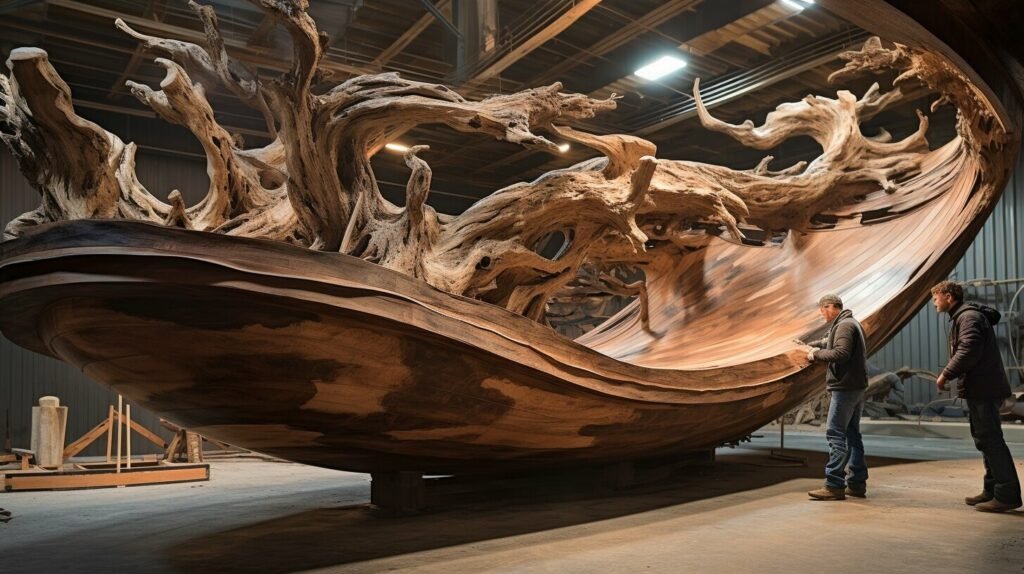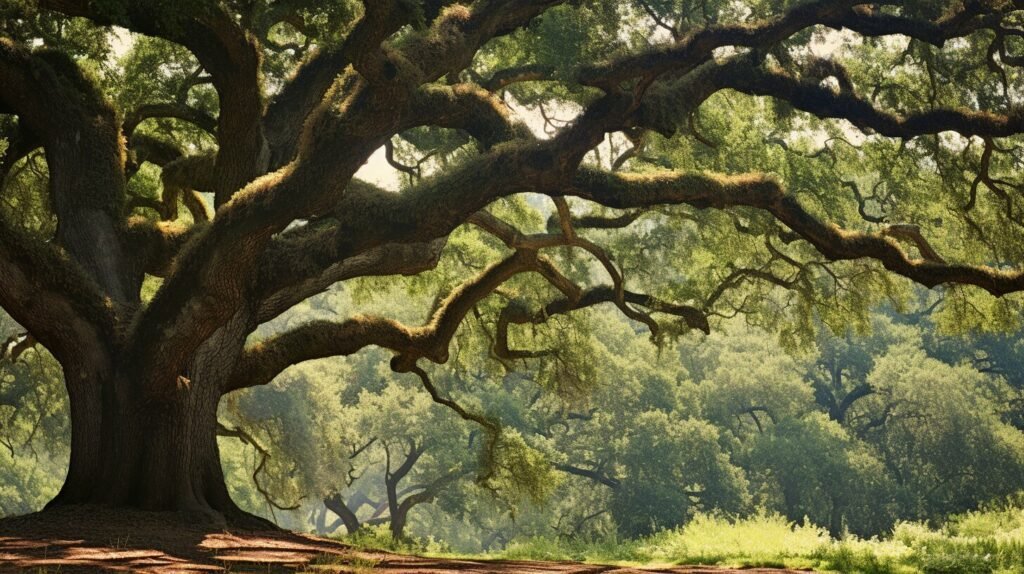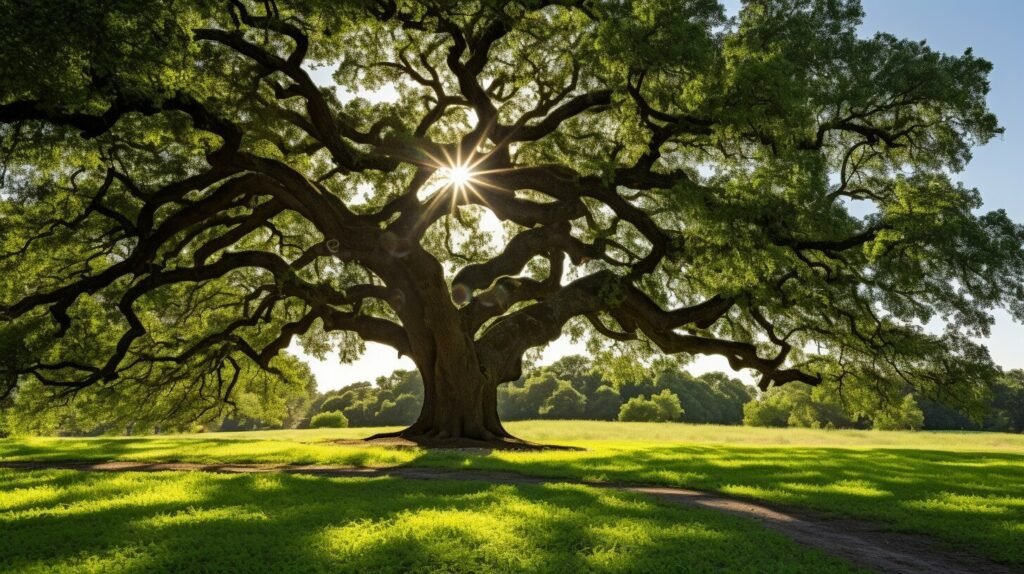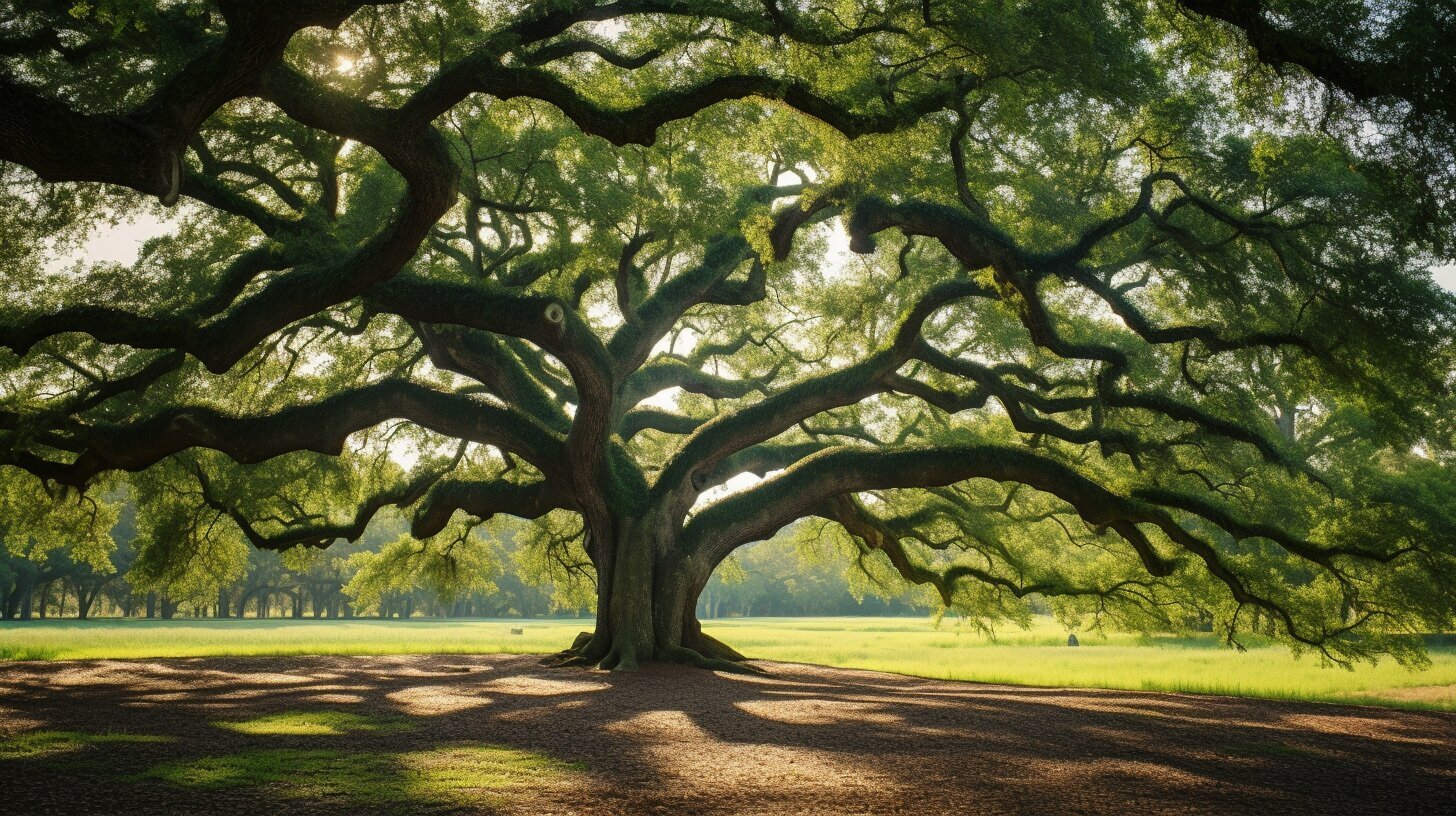The majestic oak tree, belonging to the Quercus species, is a symbol of strength and natural beauty. This grand tree species, with its towering presence and allure, captivates the hearts of those who encounter it.
Found in various parts of the south, particularly in the Outer Banks of North Carolina and the city of Savannah, Georgia, the oak tree, especially the Southern Live Oak (Quercus virginiana), holds a special place in the hearts of many. With crowns that span up to 150 feet in diameter, these mighty giants exhibit a remarkable stature and longevity.
Key Takeaways:
- The majestic oak tree, belonging to the Quercus species, symbolizes strength and natural beauty.
- The Southern Live Oak, with its impressive crown size, is renowned for its size and longevity.
- Oak trees have played a vital role in the shipbuilding industry and continue to provide shelter and food for wildlife.
- Oak trees, such as the Sand Live Oak, are almost evergreen, shedding and regrowing their leaves throughout the year.
- These resilient trees are known for their ability to withstand extreme weather conditions and contribute to mitigating the effects of climate change.
The Beloved Sight in the South
The oak tree is a beloved sight in many parts of the American South, particularly in regions like the Outer Banks and Savannah, where the majestic Southern Live Oak thrives. These grand trees, scientifically known as Quercus virginiana, captivate visitors with their impressive size and longevity. The Southern Live Oak is especially renowned for its expansive crown, which can reach up to 150 feet in diameter, creating a breathtaking canopy that stretches across the landscape.
Table 1: Notable Oak Tree Species in the American South
| Tree Species | Location | Characteristics |
|---|---|---|
| Southern Live Oak (Quercus virginiana) | Outer Banks, North Carolina; Savannah, Georgia | Largest crown size: up to 150 feet in diameter |
| Sand Live Oak (Quercus geminata) | Coastal areas of Florida, Alabama, and Mississippi | Used for landscaping and erosion control |
The Southern Live Oak has played a significant role in the history and culture of the South, particularly in the shipbuilding industry. The strength and durability of oak wood have made it a preferred material for constructing sturdy vessels. These trees have witnessed centuries of maritime history and continue to inspire awe with their grandeur and resilience.

The majestic oak trees of the American South also provide crucial habitat and sustenance for a diverse array of wildlife. Birds, squirrels, and other woodland creatures find shelter and food among the branches and acorns of these magnificent trees. Their contribution to the local ecosystem is invaluable, ensuring the balance and health of the surroundings.
In the face of extreme weather conditions and the challenges posed by climate change, oak trees demonstrate their remarkable resilience. Their ability to withstand storms, floods, and droughts makes them vital in protecting ecosystems and mitigating the effects of climate change. Despite their strength, oak trees face threats from ongoing development, which endanger their habitats and the wildlife that depend on them. Conservation efforts are crucial to preserve these majestic trees and raise awareness about their importance for future generations.
Majestic Stature and Longevity
Standing tall and proud, the Southern Live Oak is known for its majestic height and exceptional longevity, with some trees boasting crowns that span an impressive 150 feet in diameter. These grand, sprawling trees are truly awe-inspiring, commanding attention and admiration wherever they grow.

With their towering presence and expansive canopies, Southern Live Oaks define the landscapes they inhabit, lending an air of grace and tranquility to the surroundings. These magnificent trees have stood the test of time, bearing witness to centuries of history and playing a vital role in the ecosystems they thrive in.
The longevity of the Southern Live Oak is a testament to its resilience and adaptability. With proper care and favorable conditions, these trees can live for hundreds of years, becoming cherished landmarks and a cherished part of local heritage.
The Southern Live Oak’s Grandeur in Numbers:
| Height | Crown Diameter | Longevity |
|---|---|---|
| Up to 80 feet | Up to 150 feet | Centuries |
As a species known for its remarkable size and longevity, the Southern Live Oak exemplifies the strength and endurance of nature. These majestic trees serve as a reminder of the beauty and power of the natural world, inspiring awe and reverence in all who encounter them.
Cultural Significance
Oak trees hold a significant place in human history, particularly in the shipbuilding industry, where their strong and durable wood has been prized for constructing vessels of all sizes. The majestic oak trees, with their towering stature and wide-spreading branches, provided the ideal timber for shipbuilders, ensuring the longevity and seaworthiness of their creations.

“The oak, when it is felled, has the ability to withstand the aging process and becomes stronger over time,” said shipbuilder John Williams, a 4th-generation craftsman from the coastal town of Beaufort, North Carolina. “Its dense and sturdy wood, known for its resistance to rot and decay, was the preferred choice for keels, ribs, and planking, ensuring the structural integrity of the ship.”
The cultural significance of oak trees in the shipbuilding industry extends beyond their practical use. These majestic trees symbolize the resilience and endurance of seafaring nations throughout history. From the ancient Greeks and Romans to the European explorers of the Age of Discovery, oak trees played a vital role in shaping maritime history and allowing for the exploration and colonization of new lands.
In recognition of their cultural importance, oak trees are still celebrated today in various maritime traditions and festivals. The regal beauty and strength of these trees continue to evoke a sense of awe and reverence, reminding us of the enduring legacy of the shipbuilding industry and the nautical adventures of the past.
Shipbuilding with Oak
| Advantages of Oak Wood in Shipbuilding | Disadvantages of Oak Wood in Shipbuilding |
|---|---|
|
|
Ecosystem Contribution
Beyond their majestic presence, oak trees serve as vital lifelines for countless species, providing nourishment and shelter within their branches and canopies. These towering giants are not just a sight to behold, but also a critical source of food and habitat for a wide range of wildlife.
One of the most notable contributions of oak trees to ecosystems is their role as a primary food source. Acorns, the fruit of the oak tree, are rich in nutrients and serve as a valuable food supply for numerous animals. Squirrels, deer, turkeys, and even some bird species depend heavily on acorns as a primary source of sustenance. The abundance of acorns produced by oak trees supports both resident and migratory wildlife populations.
The branches and canopies of oak trees provide essential shelter and nesting sites for numerous bird species, including woodpeckers and owls. The dense foliage offers protection from the elements and predators, ensuring the survival and breeding success of these avian inhabitants. Additionally, the intricate network of branches provides ample opportunities for small mammals, such as squirrels and raccoons, to build their nests and find refuge.
Moreover, oak trees support a wide range of insect species, which in turn serve as a crucial food source for birds and other animals. The intricate interactions within oak tree ecosystems create a delicate balance, ensuring the vitality and diversity of entire ecosystems.
| Food | Shelter |
|---|---|
| Squirrels | Birds |
| Deer | Small mammals |
| Turkeys | Insects |
“The intricate interactions within oak tree ecosystems create a delicate balance, ensuring the vitality and diversity of entire ecosystems.”
As we cherish the beauty and grandeur of oak trees, it is essential to recognize their invaluable role in supporting wildlife and maintaining the delicate ecological balance. Conserving oak tree habitats and promoting their protection is crucial for the well-being of countless species that rely on these magnificent trees for their survival.

Oak trees possess remarkable qualities, from their versatile hardwood that finds use in various applications to their prolific production of acorns and evergreen leaves that shed and regrow continuously. The hardwood of oak trees is highly sought after for its strength and durability, making it an ideal material for furniture, flooring, and construction. The distinct grain patterns and warm hues of oak wood add an elegant touch to any space. Whether it’s a classic oak dining table or sturdy oak cabinets, this hardwood is prized for its timeless appeal and ability to withstand the test of time.
Acorns are a defining feature of oak trees, with many species producing an abundance of these seeds. Acorns are an important food source for a variety of wildlife, including birds, squirrels, and deer. The acorn’s high nutritional content and hardy shell make it an excellent source of energy for animals, especially during the winter months. Furthermore, oak trees are unique in their evergreen nature, shedding and regrowing leaves throughout the year. This characteristic ensures a constant supply of foliage, providing shelter and food for wildlife even during colder seasons.

Oak leaves are not only abundant but also visually striking. They have a distinct shape, with lobed edges and a glossy, dark green color. During the fall season, oak leaves often undergo a vibrant transformation, turning shades of orange, red, and gold. This spectacle is a testament to the natural beauty and versatility of oak trees. Whether they are used for landscaping, erosion control, or simply enjoyed in their natural habitat, oak trees and their hardwood, acorns, and evergreen leaves continue to captivate and inspire.
| Benefits of Oak Trees |
|---|
| 1. Versatile hardwood for furniture, flooring, and construction |
| 2. Abundant production of acorns, providing food for wildlife |
| 3. Evergreen leaves that shed and regrow, ensuring a constant supply of shelter and food |
Resilience in Extreme Conditions
Oak trees have proven themselves to be nature’s champions, withstanding harsh weather conditions and even playing a vital role in mitigating the effects of climate change. These majestic trees have the ability to endure extreme temperatures, strong winds, and heavy rainfall, making them a formidable presence in any landscape.
Their deep and extensive root systems anchor them firmly in the ground, providing stability and protection against erosion. This resilience allows oak trees to thrive in a variety of climates, from the scorching heat of the southern United States to the frigid temperatures of the northern regions.
Furthermore, oak trees contribute to climate change mitigation by absorbing significant amounts of carbon dioxide, a greenhouse gas that contributes to global warming. They act as natural carbon sinks, helping to reduce the concentration of CO2 in the atmosphere. This vital role in carbon sequestration makes oak trees invaluable allies in the fight against climate change.

| Extreme Weather Conditions | Adaptations of Oak Trees |
|---|---|
| High temperatures | Oak trees have thick, insulating bark that protects them from intense heat and sunlight. Their dense canopies provide shade, reducing the impact of direct sunlight on the tree’s foliage. |
| Strong winds | The flexible nature of oak tree branches allows them to sway in the wind without breaking. This adaptability helps oak trees withstand even the strongest gusts, preventing significant damage. |
| Heavy rainfall | The deep root systems of oak trees enable them to withstand periods of heavy rain. Their ability to absorb and store large amounts of water also helps prevent flooding and soil erosion. |
The resilience of oak trees in extreme conditions is a testament to their strength and adaptability. However, the ongoing development poses a threat to these majestic trees and their habitats. It is crucial to prioritize conservation efforts and raise awareness about the importance of preserving these iconic symbols of strength, resilience, and natural beauty.
Threats and Conservation Efforts
Despite their resilience, oak trees face an ever-present threat from ongoing development, making conservation efforts crucial to their survival. The majestic oak tree, with its towering presence and cultural significance, is increasingly at risk due to the expansion of urban areas and the clearing of land for agriculture and infrastructure.

This relentless development often leads to the destruction of oak forests, which serve as vital habitats for countless species of wildlife. The loss of these ecosystems not only diminishes biodiversity but also disrupts the delicate balance of our natural environment.
Recognizing the importance of oak trees and the need to protect them, conservation efforts are underway to preserve their habitats and raise awareness about their significance. Organizations and individuals are working tirelessly to advocate for the preservation of oak forests, promote sustainable land management practices, and establish protected areas for these majestic trees.
Conservation Strategies
Conservation strategies involve a combination of measures aimed at safeguarding oak trees and their ecosystems. One approach focuses on land acquisition and establishing nature reserves or protected areas specifically designated for oak tree preservation. These areas provide a safe haven for oak trees, allowing them to thrive and continue providing vital ecological services.
Another strategy involves promoting public awareness and engagement in oak tree conservation. Educational programs, workshops, and community initiatives are effective tools for spreading knowledge about the significance of oak trees and the threats they face. By involving local communities, these efforts garner support for conservation initiatives and encourage sustainable coexistence with these majestic trees.
Furthermore, research and monitoring play a crucial role in understanding the ecological needs of oak trees and their associated wildlife. These studies inform conservation practices, enabling scientists and conservationists to implement targeted measures that address specific challenges faced by oak trees.
| Conservation Efforts | Impact |
|---|---|
| Establishment of protected areas | Preserves oak tree habitats and ensures long-term survival |
| Public awareness campaigns | Increases support for oak tree conservation and promotes sustainable practices |
| Research and monitoring | Provides valuable insights for targeted conservation efforts |
Through these combined efforts, we can ensure the continued existence of these magnificent trees and their invaluable contributions to our environment. By protecting oak trees and the habitats they provide, we are preserving not only a symbol of strength and natural beauty but also a vital cornerstone of our ecosystems.
Conclusion
The oak tree continues to captivate and inspire, representing strength, resilience, and natural beauty in a world that truly cherishes its majestic presence.
With their towering height, expansive crowns, and remarkable longevity, oak trees stand as symbols of power and endurance. They have held a beloved place in the hearts of many, particularly in the southern regions of the United States, where the sight of these grand trees gracing the landscapes is cherished.
Not only do oak trees possess a remarkable physical stature, but they also hold cultural significance. Throughout history, oak wood has been prized for its strength and durability, making it a preferred choice in the shipbuilding industry. The oak tree’s contribution to maritime history and its continued presence in cultural traditions further adds to its allure.
However, the significance of oak trees extends beyond cultural admiration. These trees play a pivotal role in supporting diverse ecosystems by providing essential food and shelter for various wildlife species. Birds, squirrels, and other woodland creatures rely on oak trees for their survival, highlighting the vital contributions these majestic giants make to the natural world.
Yet, despite their resilience in withstanding extreme weather conditions and their ability to mitigate the effects of climate change, oak trees face ongoing threats from development. Efforts are being made to protect these invaluable trees and their habitats through conservation initiatives and raising awareness about their importance.
In a world that embraces the strength, resilience, and natural beauty represented by the majestic oak tree, it is crucial that we continue to cherish and protect these remarkable symbols of nature’s magnificence. By doing so, we ensure that future generations can also marvel at the grandeur of these ancient trees and appreciate the vital role they play in our world.
FAQ
Q: What is the scientific name of the oak tree?
A: The scientific name of the oak tree is Quercus.
Q: Where are oak trees most prominent in the United States?
A: Oak trees are particularly prominent in the southern regions of the United States, including the Outer Banks of North Carolina and Savannah, Georgia.
Q: What is the significance of the Southern Live Oak?
A: The Southern Live Oak is a specific type of oak tree that is renowned for its grandeur and allure in the southern regions of the United States.
Q: How tall can oak trees grow?
A: The largest oak trees, specifically the Southern Live Oak, can have crowns that reach up to 150 feet in diameter.
Q: How have oak trees played a role in the shipbuilding industry?
A: Oak wood has been historically favored for ship construction due to its strength and durability, making oak trees significant in the maritime industry.
Q: What do oak trees contribute to ecosystems?
A: Oak trees provide essential food and shelter for a variety of wildlife, including birds, squirrels, and other woodland creatures, contributing to the overall health and balance of ecosystems.
Q: Do oak trees have evergreen leaves?
A: Yes, oak trees are almost evergreen, with leaves that are shed and regrown throughout the year.
Q: How do oak trees contribute to climate change mitigation?
A: Oak trees are known for their ability to withstand extreme weather conditions, making them resilient in the face of climate change. They play a crucial role in ecosystem resilience and can help mitigate the effects of climate change.
Q: What threats do oak trees face?
A: Ongoing development poses a threat to oak trees and their habitats.
Q: What conservation efforts are being made to protect oak trees?
A: Initiatives aimed at preserving oak forests and raising awareness about the importance of these trees for future generations are being implemented to protect oak trees.




